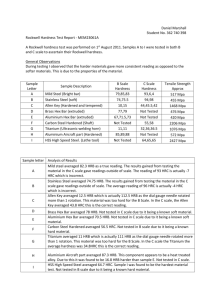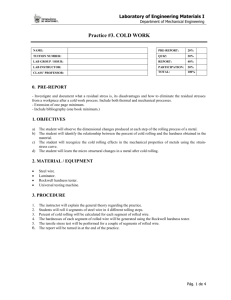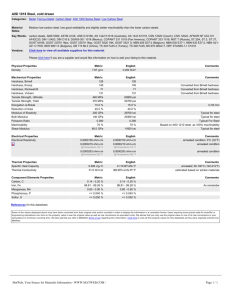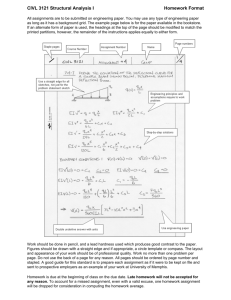Hardness Testing
advertisement
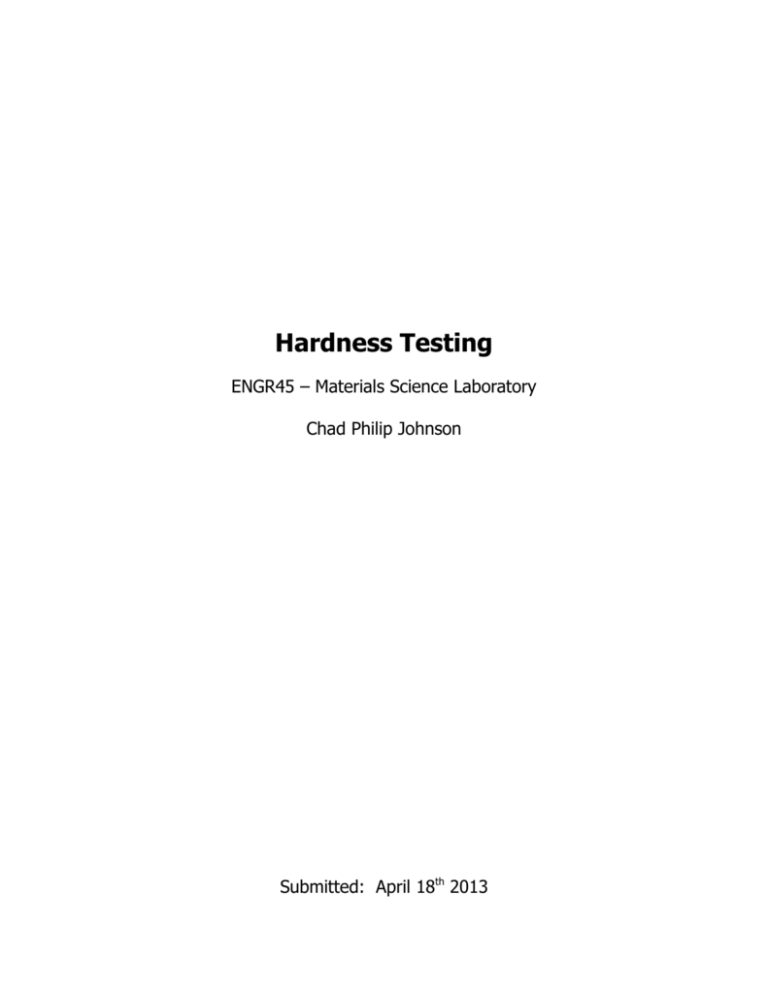
Hardness Testing ENGR45 – Materials Science Laboratory Chad Philip Johnson Submitted: April 18th 2013 Abstract All solid metals have the mechanical property called hardness. Hardness is defined as "the measure of a material's resistance to localized plastic deformation (e.g., a small dent or a scratch)" (Callister 134). For this experiment a Rockwell Hardness Tester machine was used to measure the Rockwell B-scale hardness values for five different materials: A36 steel, 7075-T651 aluminum, 316 stainless steel, cold finish 1040 steel, and hot rolled 1018 steel. Comparisons were then made between experimental values and known values in the cases where the true identity of a sample was known. It is expected that the experimental hardness values are within 5% of the true hardness values for these materials according to experimental observations, proper machine calibration, and available comparison techniques. Table 1. Experimental results and comparisons with accepted values Material Experimental Value Accepted Value (GPa) Percent Difference (%) A36 Steel 77.8 HRB - - 7075-T651 Aluminum 83.2 HRB 87 HRB 4.37% 316 Stainless Steel 100.9 HRB - - 1040 Steel (CF) 98.2 HRB - - 1018 Steel (HR) 69.9 HRB - - Procedure Samples were carefully selected and prepared before measurements were taken to ensure that each was free of pits, cracks, foriegn materials and other visually apparent defects. Effects of plastic deformation from previous experiments, typically due to indentures received through previous hardness tests, were checked to not be so great that they they would alter any future readings. Acceptable samples were then ground thoroughly with fine sandpaper to ensure that the surfaces to be tested would have clean contacts with the indenter from the Rockwell Hardness Tester. Operation of the machine required that the both the appropriate penetrator and major load be set before the testing of any samples; for the Rockwell Hardness B-scale, which was used for all five the metal samples, the 1/16in ball indenter was used. The major load of the machine's torque system was set to 100kg (one 60kg weight stacked on top of another 40kg weight) and then a sample was loaded into the machine. An appropriate site was then chosen for the indentation which was required to be at least two diameters in length from other nearby indentions so that false readings would not occur. Next the capstand in the lower right area of the machine was rotated in a clockwise direction to set the minor load. The position of the sample was adjusted until the penetrator came into contact with it beginning the loading process. Additional rotations were made until both the small and large needles in the dial aligned completely vertically at the same time. At this point the minor load was applied by slowly releasing the trip lever of the capstand and guiding it back to the stopping value. After being allowed to rest for a short duration of time a measurement was taken according Figure 1. Rockwell Hardness Tester to the position of the large needle on the dial, carefully noting the appropriate scale (HRB or HRC). Before measuring the hardness of the five samples the machine was tested with a calibration disc to observe how accurate its readings would be. The disc had a known hardness value of 57.2 +/- 0.5 HRC. Because this value was measured on the Rockwell Hardness C-scale, comparison of experimental values could only be made by adapting the machine to perform this different test. Adaptation required using the diamond tipped penetrator and applying a total of 150kg for the major load. Five calibration readings were taken and the average value was found. Next the standard deviation of these readings was calculated to obtain the bias of the machine using the formula: STD = √ ( x−μ)2 ∑ n−1 where the character μ is the average value of the measurements. The standard deviation was used to understand qualities regarding the accuracy of the machine and to determine any systematic error, or bias, that existed. Other noted sources of error in the experimental procedure included the plane on which the Rockwell Hardness Tester rested not being entirely flat (it was positioned on top of a folding table which sagged slightly in the center under the weight of the device), the tester not being appropriately leveled prior to the experiment, and minor imprecisions with each setting of the minor load due to the machine operator's approximations through manual adjustments. (NOTE: A student tdistribution test could not be prepared in time for this report due to the writer's unfamiliarity with the method.) Results Following from the calibration procedure, the average value of the calibration readings was found to be μ = 57.3 HRC. This produced a standard deviation value of std = 0.163. The percent difference between the average measured value and the true value of 57.2 +/- 0.5 HRC was found to be only 0.105%, indicating that the machine was producing accurate measurements. For the five different material samples the following values were obtained: a) A36 steel with 77.8 HRB; b) 7075-T751 aluminum with 83.2 HRB; c) 316 stainless steel with 100.9 HRB; d) cold finish 1040 steel with 98.2 HRB; and e) hot rolled 1018 steel with 69.9 HRB. All reported hardness values represent the calculated average value from many repeated readings for each sample. In nearly all cases direct comparisons to known values could not be made. This is due to the many different varieties of a particular steel that exist, all of which have unique tensile strengths and hardness values, and that all of our samples except for one were without the requisite specifiers to determine the exact variety being tested. The exception to this was for 7075-T751 aluminum which has an accepted Rockwell Hardness value of 87 HRB (MatWeb). This compares favorably to the average experimental value of 83.2 HRB and produces a percent difference of about 4.37%, suggesting that the average readings for the other material samples were also within this same range of error. Conclusion Improvements are required to the experimental procedure and analysis of data to better interpret the results of this experiment. Currently the greatest limiting factor in the procedure is that only the general identities of the four steel samples are known and thus experimental values cannot be compared to other sources of data nor accepted values. For the analysis of data, a student t-distribution test would provide more details regarding the precision of the Rockwell Hardness Tester and would allow for a better understanding of measured values. Overall the machine and measurement process worked consistently and it is expected that the average measured values are approximately 5% of the true values. References Aluminum 7075-T6; 7075-T651. MatWeb.com. MatWeb. Accessed 18 April 2013. <http://www.matweb.com/search/DataSheet.aspx?MatGUID=4f19a42be94546b686bbf43f79c51b7d> Callister, Jr., W.D. Materials Science and Engineering, An Introduction. 6th ed. New York, NY: John Wiley & Sons, Inc., 2003.
